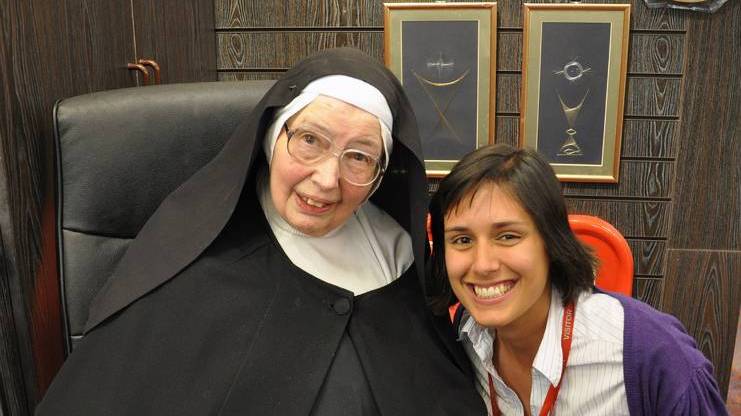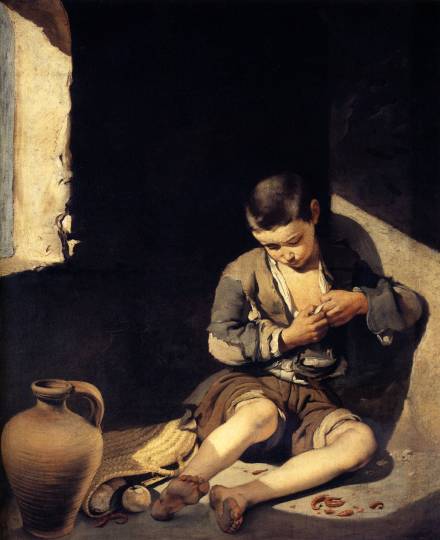



Farewell, Sister Wendy
Kristina Glicksman
Thursday, January 17, 2019

In this 2011 file photo, Sister Wendy Beckett poses with an unidentified admirer during a book signing at St. Pauls Bookshop in London. (CNS photo/Jo-Anne Rowney, courtesy of St. Pauls Bookshop)
Over the Christmas holiday I disconnected from the world somewhat, so it was only last week as I was catching up on some of my reading that I came across the obituary of an unlikely celebrity: Sister Wendy Beckett – Catholic nun, hermit, and renowned and well-loved television art critic.
That name and the image of that black-wimpled, bespectacled nun with the buck teeth immediately took me back to a moment of my own past.
Twenty years ago I was a senior in high school taking an elective course in European cultural history. Sister Wendy Beckett appeared in our classroom via the magic of VHS as one of our regular teaching aids, and through the boisterous humour of teenage boys (which always baffled me), she quickly became our class mascot.
Sister Wendy became a television phenomenon in the ‘90s with BBC programs like Sister Wendy’s Odyssey and Sister Wendy’s Grand Tour in which she wandered throughout the great galleries and museums of Britain and Europe narrating her understanding of great masterpieces and lesser known works.
As a 17-year-old, I was less than impressed. Not with the art – I loved everything I saw – but with Sister Wendy. Her art history was the sort that was lacking in dates, techniques, and influences. She focused completely on the artwork and what it meant to her. Her understanding of art was entirely subjective, and that bothered me. I wanted to know things, to be able to be right about them. I wanted to understand art the way a doctor understands his patients. Sister Wendy approached art as a lover.
Watching her again all these years later, I see a different woman. I see a woman of simplicity and humble confidence sharing her unselfconscious, unapologetic, passionate, and deeply personal views of art. As she says during one episode of Sister Wendy’s Odyssey:
 It’s thanks to them that I could walk by the crowds swarming the Mona Lisa (no slur on Da Vinci – I just couldn’t get close enough!) to explore the less well-loved treasures. And it was in a quiet corner of the Louvre that I became transfixed by a simple, tender painting of a small boy depicted in loving detail from his closely-shorn head to his dirty, bare feet. And I fell in love with an artist whose name was then unknown to me: Bartolomé Esteban Murillo, that celebrated 17th-century Spanish painter.
But perhaps more importantly, Sister Wendy showed us how to approach art (the good stuff, anyway) as Christians: always looking for the human element, the story within and behind it, and treating it with love and compassion. She taught us not to be afraid of the secular because God touches every part of human existence.
So, farewell, Sister Wendy. And thank you.
It’s thanks to them that I could walk by the crowds swarming the Mona Lisa (no slur on Da Vinci – I just couldn’t get close enough!) to explore the less well-loved treasures. And it was in a quiet corner of the Louvre that I became transfixed by a simple, tender painting of a small boy depicted in loving detail from his closely-shorn head to his dirty, bare feet. And I fell in love with an artist whose name was then unknown to me: Bartolomé Esteban Murillo, that celebrated 17th-century Spanish painter.
But perhaps more importantly, Sister Wendy showed us how to approach art (the good stuff, anyway) as Christians: always looking for the human element, the story within and behind it, and treating it with love and compassion. She taught us not to be afraid of the secular because God touches every part of human existence.
So, farewell, Sister Wendy. And thank you.
“All great art deals with human emotions and takes us deep into somebody else’s world so we can learn more about ourselves.”Sister Wendy wasn’t teaching us so much about art as about herself. Art was an important part of her prayer life, and she shared that life of profound spirituality with us. It’s not obvious at first because many of the works she looked at had no obvious religious theme. But her deep relationship with God informed her relationship with the world and so inspired and informed her love of art. And art, in turn, helped to deepen her spirituality. Listening to Sister Wendy, it’s easy to see how, for someone who is open and attentive, art is a form of dialogue with the viewer as an active participant, bringing his or her own experiences, personality, and idiosyncrasies to the conversation. And all these years later, I wonder if maybe Sister Wendy did have an influence on me after all. It’s people like Sister Wendy who give people like me the confidence to decide for ourselves what art we do or don’t like and what that art means to us, but they also challenge us to look really closely and to pay attention. It’s because of them that I can unashamedly stroll through an art gallery without stooping and shuffling along, looking slavishly at every wheelchair-accessible label, insisting with confidence (or is it just pig-headedness?) that a piece has to grab me in order to be worthy of my attention – and knowing that on any given day that may be a different piece.
 It’s thanks to them that I could walk by the crowds swarming the Mona Lisa (no slur on Da Vinci – I just couldn’t get close enough!) to explore the less well-loved treasures. And it was in a quiet corner of the Louvre that I became transfixed by a simple, tender painting of a small boy depicted in loving detail from his closely-shorn head to his dirty, bare feet. And I fell in love with an artist whose name was then unknown to me: Bartolomé Esteban Murillo, that celebrated 17th-century Spanish painter.
But perhaps more importantly, Sister Wendy showed us how to approach art (the good stuff, anyway) as Christians: always looking for the human element, the story within and behind it, and treating it with love and compassion. She taught us not to be afraid of the secular because God touches every part of human existence.
So, farewell, Sister Wendy. And thank you.
It’s thanks to them that I could walk by the crowds swarming the Mona Lisa (no slur on Da Vinci – I just couldn’t get close enough!) to explore the less well-loved treasures. And it was in a quiet corner of the Louvre that I became transfixed by a simple, tender painting of a small boy depicted in loving detail from his closely-shorn head to his dirty, bare feet. And I fell in love with an artist whose name was then unknown to me: Bartolomé Esteban Murillo, that celebrated 17th-century Spanish painter.
But perhaps more importantly, Sister Wendy showed us how to approach art (the good stuff, anyway) as Christians: always looking for the human element, the story within and behind it, and treating it with love and compassion. She taught us not to be afraid of the secular because God touches every part of human existence.
So, farewell, Sister Wendy. And thank you.Related Articles:
<<
SUPPORT LABEL
$50
$100
$150
$250
OTHER AMOUNT
DONATE
Receive our newsletters
Stay Connected
Receive our newsletters

Stay Connected







